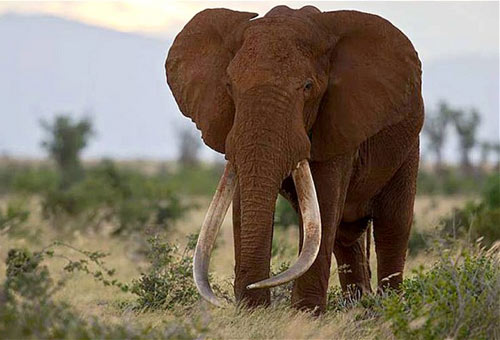
|
Poachers have killed one of the world’s largest elephants – a famed great tusker named Satao – in Tsavo East National Park in Kenya. Wildlife officials revealed that Satao, a giant elephant with tusks that nearly reached the ground, has died after being shot with poisoned arrows in late May. Conservationists describe how the bull elephant had intentionally hid in bushes to conceal his sweeping tusks, which were estimated to each weigh around 45kg. Satao’s death at the age of around 45 years is the latest in a massive upsurge of poaching of the mammals for their ivory across the African continent. Wildlife officials found Satao’s carcass was found with his face hacked off and weighty tusks removed. Richard Moller, of The Tsavo Trust, who had been monitoring Satao for several months confirmed that the elephant found dead on May 30 was indeed Satao, whom he called "an icon". "There is no doubt that Satao is dead, killed by an ivory poacher’s poisoned arrow to feed the seemingly insatiable demand for ivory in far-off countries," Mr Moller said. "A great life lost so that someone far away can have a trinket on their mantelpiece. "The loss of such an iconic elephant is the most visible and heart-rending tip of this iceberg, this tragedy that is unfolding across the continent," added Frank Pope of Save The Elephants in Nairobi. A soaring demand for ivory in a number of Asian nations has seen poaching hit levels that were last reached in the 1980s before the ivory trade was banned. The street value of elephant tusk is believed to exceed thousands of dollars per kilo and officials have acknowledged the role of organised crime in the poaching crisis. More than 20,000 African elephants were slaughtered in 2013, according to the Convention on International Trade in Endangered Species of Wild Fauna and Flora (CITES). The Kenya Wildlife Service has documented the killing of 97 elephants so far this year, but experts dispute the official figures. Dr Paula Kahumbu, who leads the Hands Off Our Elephants campaign, wrote that – based on the reports she has seen – “elephant poaching in Kenya is at least 10 times the official figures”. Earlier this month, police seized more than 200 elephant tusks in a warehouse in the port city of Mombasa, weighing over 2,000kg. |
在肯尼亚东察沃国家公园,偷猎者杀死一头世界上最大的大象——有名的长牙大象萨韬(Satao)。 野生动物官员透露,有着几乎长及地面长牙的萨韬,在五月底被毒箭射中后死亡。 自然资源保护学家描述了这头公象是如何故意躲在灌木丛中来隐藏它的长象牙。它的长象牙每个约重45千克。 45岁萨韬的死亡只是非洲大陆上为了象牙而大肆猎杀大象现象中的最近一例。 野生动物官员发现萨韬的尸体发现时,它的脸已经被劈开,重重的象牙被拔走了。 Tsavo基金会(Tsavo Trust)的理查兹·莫勒(Richars Moller)已经观察萨韬几个月了,他证实这头在5月30日被猎杀的大象就是萨韬。他称萨韬为“一个符号”。 莫勒说:“毫无疑问,萨韬死了,被象牙偷猎者的毒箭给害死了,就是为了满足来自那些遥远国家对象牙看起来贪得无厌的需求。 “一个伟大生命的消逝,就是为了某个人可以在壁炉上有个饰品。 “在内罗毕拯救大象”活动的弗兰克·波普(Frank Pope)补充道:“这一标志性大象的死亡,只是这冰山上最明显最令人心碎的一角。这样的悲剧正席卷全大陆。” 一些亚洲国家对象牙的需求急剧增加,这就使得偷猎死灰复燃,重新达到了20世纪80年代象牙交易被禁之前的水平。 象牙的市场价格每公斤超过数千美元。官方承认在偷猎危机中组织了犯罪活动。 根据濒危野生动植物种国际贸易公约(CITES),在2013年,有2万头非洲象被猎杀。 在今年,肯尼亚野生动物保护局已经记载有97头大象被杀,但是专家对官方数据持怀疑态度。 领导“放开我们的大象”活动的宝拉·卡呼卜博士(Dr Paula Kahumbu)依据她所看到的新闻写到:“在肯尼亚被猎杀大象的真正数量至少是官方数字的10倍。” 本月早些时候,警方在港口城市蒙巴萨的一个仓库没收了200多个象牙,总重量超过2000千克。 (译者 孙喆 编辑 丹妮) 扫一扫,关注微博微信
  |
